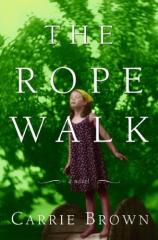The Rope Walk
Review
The Rope Walk
There are novels driven by either character or plot, and at least one more category that might best be described as "atmospheric," in which the author sets herself the principal task of creating gorgeous word pictures that lodge themselves indelibly in our subconscious. Carrie Brown's sixth novel fits comfortably into this last group, the book's ravishing images destined to linger in the mind long after the details of its quiet story are forgotten.
THE ROPE WALK opens on May 29, 2005, Alice MacCauley's 10th birthday. Alice, a redhead and something of a tomboy, lives with her father Archie, a Shakespeare scholar and dean of a small college, and five older brothers in the town of Grange, Vermont. Her mother had died in a horse riding accident one month after Alice's birth. At her birthday party Alice meets two people who will change her life over the course of the summer during which most of the novel's action is concentrated: Theo Swann, the mixed-race grandson of family friends who has come from New York City to spend the summer, and Kenneth Fitzgerald, a prominent artist whose eccentric sister is caring for him as he is dying of AIDS.
On the evening of Alice's party, Theo's grandmother suffers a stroke. The MacCauley family takes him in as a temporary accommodation, but a bond quickly grows between the children and it soon becomes apparent that he's destined to spend the summer with them. Theo is a preternaturally bright boy who believes any problem can be solved with a toolbox and a bit of imagination, and his urban upbringing has made him more sophisticated than Alice. Still, he lacks her courage, fleeing from their initial encounter with Fitzgerald, who is disfigured from the effects of his disease and grabbing Alice's shirt at moments of stress.
Fitzgerald befriends Alice and Theo, inviting them to his sister's house to help him pass the long hours of enforced idleness brought on by the ravages of his illness. Each day he leaves them with an obscure word like "sempiternal" and "bagatelle," to spark their intellectual curiosity. He gives Alice and Theo his stunning mobiles, and the children take turns reading excerpts from the journals of Lewis and Clark, the account of their perilous westward journey serving as a metaphor for Alice and Theo's budding maturity. On a more concrete level, the explorers' tales inspire the children to erect a fort on an island in the shallow river that traverses the MacCauleys' land. Eventually, they decide to hack their way through the nearby woods to create the rope walk of the novel's title in a plan to give Fitzgerald an opportunity to escape the prison in which his disease has locked him. The unforeseen result of their project creates the novel's climactic event.
Some of THE ROPE WALK's characters, chiefly Alice's rambunctious brothers and, to a lesser extent, her emotionally distant father, feel slightly underdeveloped and, at best, almost peripheral to the story. Perhaps this is a consequence of the fact that the novel is narrated so skillfully through Alice's observant eyes. Brown succeeds admirably in channeling the character in a pitch-perfect rendition of the thoughts and emotions of a young girl poised on the edge of adolescence. When she describes Alice's realization that "for the first time happiness and sadness, beauty and cruelty had begun to join together inside her, entwining themselves inextricably like the tendrils of a vine up the trunk of a tree," she writes about a person with whom she's on intimate terms.
For anyone old enough to remember languid summers that seemed to float by in an endless reel of sunny days, Brown's shimmering prose will evoke that experience in all its luminous and transient beauty. "The days wore on through July," she writes, "warmer and warmer, longer and longer, slow bees droning in the garden, the light of the sloping, golden afternoons so rich it seemed to melt over the towering trees at the edge of the lawn." Passages like that one and countless others in THE ROPE WALK remind us of one of the principal reasons why we read: to experience the unalloyed pleasure of watching a skilled writer layer arresting images and acute insights onto a canvas to create a work of art.
Reviewed by Harvey Freedenberg on January 24, 2011
The Rope Walk
- Publication Date: May 1, 2007
- Genres: Fiction
- Paperback: 336 pages
- Publisher: Pantheon
- ISBN-10: 0375424636
- ISBN-13: 9780375424632










